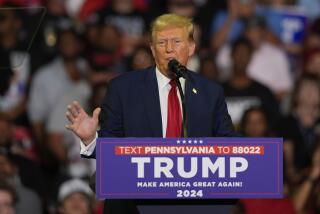Editorial: Trump’s infrastructure plan isn’t a plan. It’s a fantasy

President Trump’s infrastructure plan isn’t a plan. It’s fantasy. The outline the administration put forth Monday is essentially this: The federal government will offer a diminished amount of money — $200 billion over 10 years — for building or repairing roads, bridges, airports, seaports, energy projects and water systems and somehow, magically, $1.5 trillion to $1.8 trillion in infrastructure spending will materialize.
Where would all that money come from? The president’s framework doesn’t say, but the intent is for the federal government to spend a lot less money on infrastructure and for local and state governments to spend a lot more. Oh, and private investors are expected to rain down money on infrastructure projects too.
So far, his plan is all gleam, no grit.
Trump’s long-awaited plan was supposed to be an ambitious effort to build, as he put it, “the best, fastest and most reliable infrastructure in the world.” It was also a rare opportunity for bipartisan cooperation; Democrats and Republicans generally agree that crumbling roads and bridges are bad, and together they have been drawing up multibillion-dollar infrastructure spending plans for decades.
But the Trump framework is short on funding and pragmatism. The plan calls for $200 billion in federal spending over a decade, but much of that money is set aside for rural communities and loan programs. One hundred billion dollars would go to competitive grants, providing a mere $10 billion a year for roads, railroads, airports, water treatment plants, flood control systems and contaminated land cleanups.
That’s barely enough money to make a dent in the estimated $2 trillion of needed transportation, water and energy system upgrades. By way of comparison, the federal government spent $96 billion on transportation and water projects alone in 2014.
The $200 billion wouldn’t be new money. It would be paid for by cutting other infrastructure-funding programs. Trump’s budget, which was also released Monday, would slash funding for the Department of Transportation and the Environmental Protection Agency, among other agencies.
The Trump plan envisions it can do more with less by requiring localities to put up at least 80% of the required funding. Traditionally, the federal government covered 80% of major transportation projects, with locals contributing 20%.
There’s nothing wrong with requiring localities to kick in a significant portion of the bill for regional projects. A Trump aide singled out Los Angeles County’s Measure M sales tax increase as a “good case study” for how locals could help pay for public transit and road improvements.
In fact, cities, counties and states across the country are raising their gas and sales taxes and passing bonds to help tackle the massive backlog of unmet needs. But Measure M and similar efforts are supposed to complement, not replace, federal funding. Without federal money, projects will take longer to build, fewer jobs will be created and backlogs will lengthen. The federal pullback sought by Trump ignores why the federal government has been contributing so much to state and local infrastructure projects: We have a shared national interest in a country that’s safe and well-connected, and where people and goods move efficiently.
The Measure M-funded public transit building boom in L.A. County relies on federal funding that would be slashed under the president’s infrastructure and budget proposals. The Purple Line subway to Westwood was slated to receive more than $1 billion, or roughly 45% of the total cost, from the federal government. Without that money, it will be extremely difficult to complete that project, as well as others, in time for the 2028 Summer Olympics in Los Angeles.
Trump’s plan isn’t all terrible. It would reserve funding specifically for rural communities and transformative but challenging projects, two areas where it can be harder to raise local and private dollars. And to usher vital infrastructure projects faster through the bureaucratic gantlet, it calls for streamlining approvals so projects can get started in two years or less. That would be a welcome change, assuming that it means reducing unnecessary delays rather than gutting safety and environmental protections.
So by all means, streamline permitting and cut bureaucracy. But it’s still going take money to build the “gleaming new roads, bridges, highways, railways, and waterways” that Trump says he wants. So far, his plan is all gleam, no grit.
Follow the Opinion section on Twitter @latimesopinion and Facebook
More to Read
A cure for the common opinion
Get thought-provoking perspectives with our weekly newsletter.
You may occasionally receive promotional content from the Los Angeles Times.










